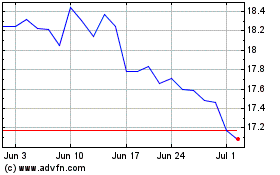By Rebecca Smith
The mayors of Oakland, Sacramento and more than a dozen other
California municipalities are joining San Jose in a campaign to buy
out the investor-owned PG&E Corp. and turn it into a giant
customer-owned cooperative.
The idea, first floated last month by San Jose Mayor Sam
Liccardo, is winning support from mayors and county officials who
represent nearly one-third of the population served by PG&E's
utility subsidiary, Pacific Gas & Electric Co.
The coalition is asking the California Public Utilities
Commission and Gov. Gavin Newsom to consider the option seriously
before the state approves any bankruptcy reorganization plan.
PG&E filed for chapter 11 protection in January, citing an
estimated $30 billion in wildfire liabilities.
By law, the utilities commission must determine that any plan
approved by a federal bankruptcy court is in the public interest
before it can be implemented. That is why the coalition is seeking
to persuade the commission and state leaders that their idea has
merit.
PG&E has adamantly opposed the sale of any part of its
system. Chief Executive Bill Johnson last month rejected an offer
by San Francisco to buy the portion of PG&E's electric network
that is within city limits for $2.5 billion. The company has also
said it isn't interested in being converted into an electric and
gas cooperative -- an idea known as mutualization, which would
transfer ownership from investors to customers.
"PG&E's facilities are not for sale, and to do so would not
be consistent with our charter to operate or our mission to serve
Northern and Central California communities," the company said when
The Wall Street Journal first reported the cooperative proposal on
Oct. 21. PG&E didn't immediately respond to a request for
comment Tuesday.
Sacramento Mayor Darrell Steinberg said that his city, which has
its own municipal electric utility but relies on PG&E for gas
service, has to start considering alternatives.
"I'm signing on in solidarity with my fellow mayors whose
constituents are suffering under PG&E," said Mr. Steinberg, a
Democrat who formerly led the state senate. He added that his city
enjoys "the benefit of electricity being a public commodity and
overseen by people who are accountable to the public."
Stockton Mayor Michael Tubbs said his constituents worry about
power shut-offs by PG&E whenever "the wind picks up." Mr. Tubbs
said that creating a customer-owned utility "allows us to put
people ahead of profits, safety ahead of dividends and local
control ahead of corporate rule."
Last week, Mr. Newsom named Ana Matosantos, his cabinet
secretary, as the state's new energy czar. He instructed her to try
to broker a deal between PG&E's shareholders and bondholders --
who are fighting for control of the company -- to enable the
PG&E to exit bankruptcy by the middle of next year. If the
sides can't reach agreement, California might intervene and pursue
other options, including a state takeover of the company, Mr.
Newsom said.
The Democratic governor is scheduled to meet with
representatives of the different stakeholders in the bankruptcy
case on Tuesday.
Mr. Liccardo said that public officials in the coalition feel
the existing bankruptcy reorganization plans are unlikely to
produce a utility strong enough to fulfill the state's need for
reliable, affordable service.
"The governor has opened a door for us by getting directly
involved," Mr. Liccardo said. "That means we have an opportunity to
see a reorganized utility emerge that doesn't just fulfill the
legal requirements under bankruptcy law but could address the
larger public need for a more responsive utility."
Under the coalition's buyout proposal, bonds worth as much as
$50 billion would be sold to finance a customer-led buyout of the
big utility, whose territory spreads across 70,000 square miles of
Northern and Central California. Customers would repay bonded
indebtedness through their monthly energy bills.
While electric cooperatives are common, especially in rural
parts of the U.S., the one proposed by the California mayors would
be the nation's largest by a long shot. It isn't clear how such an
utility would be governed. Some cooperatives have commissioners
elected by geographic districts. But state officials might want to
have some say-so to ensure the board had experts in finance, safety
and other matters.
A cooperative would have certain advantages, including more
money to reinvest in its networks because it wouldn't pay federal
taxes or shareholder dividends. It might also qualify for
lower-cost financing than an investor-owned utility.
Disadvantages would include the risk assumed by customers in
shouldering the financial burden for all future liabilities from
PG&E's aging electric grid. A cooperative would also have to
settle on fair value with PG&E, a deal that could be difficult
to strike given the company's reluctance to sell.
S. David Freeman, former head of the Los Angeles Department of
Water and Power and the Tennessee Valley Authority, said an
electric cooperative would have a huge task ahead to remake
PG&E into a safer utility.
But he said it is "nothing bigger than what TVA took on in the
1930s" providing services to the Tennessee Valley during the Great
Depression. He added that "a public agency will be devoted to
keeping the lights on and not burn down people's homes, and will
charge whatever is needed to make that happen."
In a draft of a letter sent to the utilities commission and the
governor, which was reviewed by the Journal, coalition members said
they aren't pursuing public ownership because of "mere anger or
angst" at PGE's power shut-offs but because they think the utility
has to be "re-imagined."
The coalition wrote that the bankruptcy proceeding has brought
Wall Street investor groups into conflict, creating a "spectacle,
without regard for what will be left behind when the financial
players inevitably leave the scene."
"We face the need for a completely re-engineered and
reconstructed system to adapt to the realities of climate change
and poorly maintained infrastructure," the letter to the CPUC and
Mr. Newsom says. "PG&E cannot meet these challenges if it
stumbles out of bankruptcy, barely able to raise capital, and
suffering prohibitive costs."
In addition to San Jose, Oakland and Sacramento, Mr. Liccardo
said the coalition has garnered support from mayors representing
Berkeley, Chico, Cotati, Elk Grove, Hayward, Modesto, Petaluma,
Redding, Richmond, Santa Cruz, Scotts Valley, Sonoma, Stockton,
Sunnyvale and Windsor. He said commission chairs from Marin, Santa
Cruz, San Benito and Yolo counties also are supporters.
Write to Rebecca Smith at rebecca.smith@wsj.com
(END) Dow Jones Newswires
November 05, 2019 14:57 ET (19:57 GMT)
Copyright (c) 2019 Dow Jones & Company, Inc.
PG&E (NYSE:PCG)
Historical Stock Chart
From Mar 2024 to Apr 2024

PG&E (NYSE:PCG)
Historical Stock Chart
From Apr 2023 to Apr 2024
